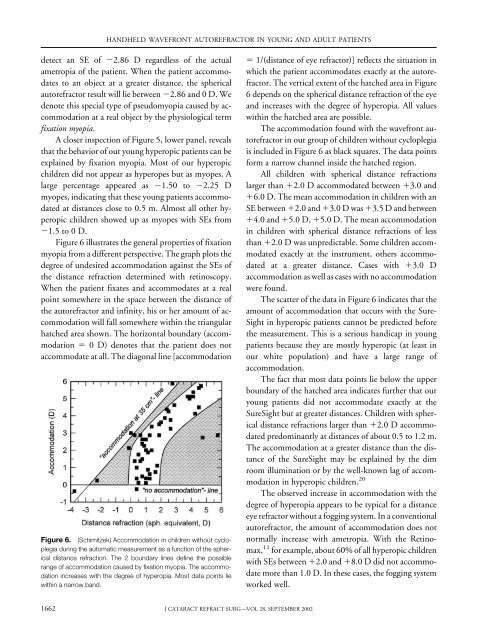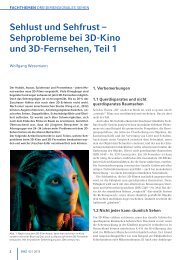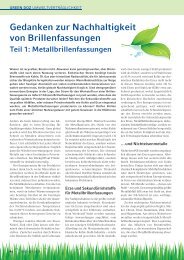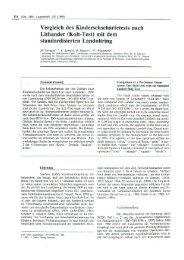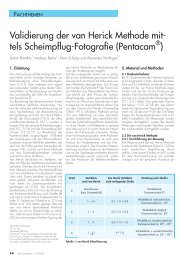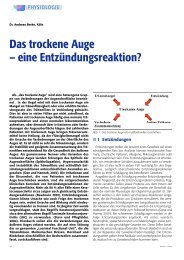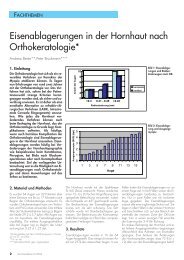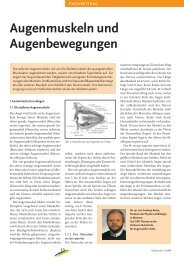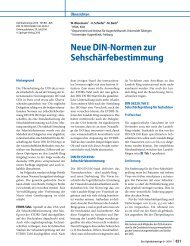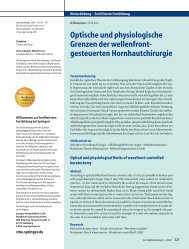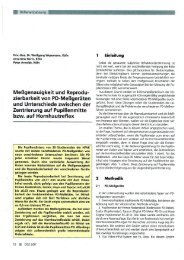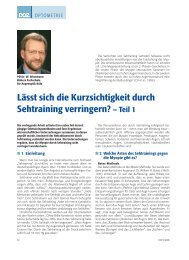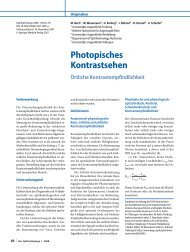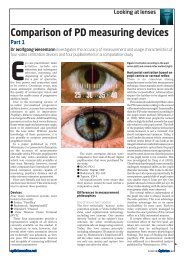Clinical evaluation of refraction using a handheld wavefront ...
Clinical evaluation of refraction using a handheld wavefront ...
Clinical evaluation of refraction using a handheld wavefront ...
You also want an ePaper? Increase the reach of your titles
YUMPU automatically turns print PDFs into web optimized ePapers that Google loves.
detect an SE <strong>of</strong> 2.86 D regardless <strong>of</strong> the actual<br />
ametropia <strong>of</strong> the patient. When the patient accommodates<br />
to an object at a greater distance, the spherical<br />
autorefractor result will lie between 2.86 and 0 D. We<br />
denote this special type <strong>of</strong> pseudomyopia caused by accommodation<br />
at a real object by the physiological term<br />
fixation myopia.<br />
A closer inspection <strong>of</strong> Figure 5, lower panel, reveals<br />
that the behavior <strong>of</strong> our young hyperopic patients can be<br />
explained by fixation myopia. Most <strong>of</strong> our hyperopic<br />
children did not appear as hyperopes but as myopes. A<br />
large percentage appeared as 1.50 to 2.25 D<br />
myopes, indicating that these young patients accommodated<br />
at distances close to 0.5 m. Almost all other hyperopic<br />
children showed up as myopes with SEs from<br />
1.5 to 0 D.<br />
Figure 6 illustrates the general properties <strong>of</strong> fixation<br />
myopia from a different perspective. The graph plots the<br />
degree <strong>of</strong> undesired accommodation against the SEs <strong>of</strong><br />
the distance <strong>refraction</strong> determined with retinoscopy.<br />
When the patient fixates and accommodates at a real<br />
point somewhere in the space between the distance <strong>of</strong><br />
the autorefractor and infinity, his or her amount <strong>of</strong> accommodation<br />
will fall somewhere within the triangular<br />
hatched area shown. The horizontal boundary (accommodation<br />
0 D) denotes that the patient does not<br />
accommodate at all. The diagonal line [accommodation<br />
Figure 6. (Schimitzek) Accommodation in children without cycloplegia<br />
during the automatic measurement as a function <strong>of</strong> the spherical<br />
distance <strong>refraction</strong>. The 2 boundary lines define the possible<br />
range <strong>of</strong> accommodation caused by fixation myopia. The accommodation<br />
increases with the degree <strong>of</strong> hyperopia. Most data points lie<br />
within a narrow band.<br />
1662<br />
HANDHELD WAVEFRONT AUTOREFRACTOR IN YOUNG AND ADULT PATIENTS<br />
J CATARACT REFRACT SURG—VOL 28, SEPTEMBER 2002<br />
1/(distance <strong>of</strong> eye refractor)] reflects the situation in<br />
which the patient accommodates exactly at the autorefractor.<br />
The vertical extent <strong>of</strong> the hatched area in Figure<br />
6 depends on the spherical distance <strong>refraction</strong> <strong>of</strong> the eye<br />
and increases with the degree <strong>of</strong> hyperopia. All values<br />
within the hatched area are possible.<br />
The accommodation found with the <strong>wavefront</strong> autorefractor<br />
in our group <strong>of</strong> children without cycloplegia<br />
is included in Figure 6 as black squares. The data points<br />
form a narrow channel inside the hatched region.<br />
All children with spherical distance <strong>refraction</strong>s<br />
larger than 2.0 D accommodated between 3.0 and<br />
6.0 D. The mean accommodation in children with an<br />
SE between 2.0 and 3.0 D was 3.5 D and between<br />
4.0 and 5.0 D, 5.0 D. The mean accommodation<br />
in children with spherical distance <strong>refraction</strong>s <strong>of</strong> less<br />
than 2.0 D was unpredictable. Some children accommodated<br />
exactly at the instrument, others accommodated<br />
at a greater distance. Cases with 3.0 D<br />
accommodation as well as cases with no accommodation<br />
were found.<br />
The scatter <strong>of</strong> the data in Figure 6 indicates that the<br />
amount <strong>of</strong> accommodation that occurs with the Sure-<br />
Sight in hyperopic patients cannot be predicted before<br />
the measurement. This is a serious handicap in young<br />
patients because they are mostly hyperopic (at least in<br />
our white population) and have a large range <strong>of</strong><br />
accommodation.<br />
The fact that most data points lie below the upper<br />
boundary <strong>of</strong> the hatched area indicates further that our<br />
young patients did not accommodate exactly at the<br />
SureSight but at greater distances. Children with spherical<br />
distance <strong>refraction</strong>s larger than 2.0 D accommodated<br />
predominantly at distances <strong>of</strong> about 0.5 to 1.2 m.<br />
The accommodation at a greater distance than the distance<br />
<strong>of</strong> the SureSight may be explained by the dim<br />
room illumination or by the well-known lag <strong>of</strong> accommodation<br />
in hyperopic children. 20<br />
The observed increase in accommodation with the<br />
degree <strong>of</strong> hyperopia appears to be typical for a distance<br />
eye refractor without a fogging system. In a conventional<br />
autorefractor, the amount <strong>of</strong> accommodation does not<br />
normally increase with ametropia. With the Retinomax,<br />
11 for example, about 60% <strong>of</strong> all hyperopic children<br />
with SEs between 2.0 and 8.0 D did not accommodate<br />
more than 1.0 D. In these cases, the fogging system<br />
worked well.


